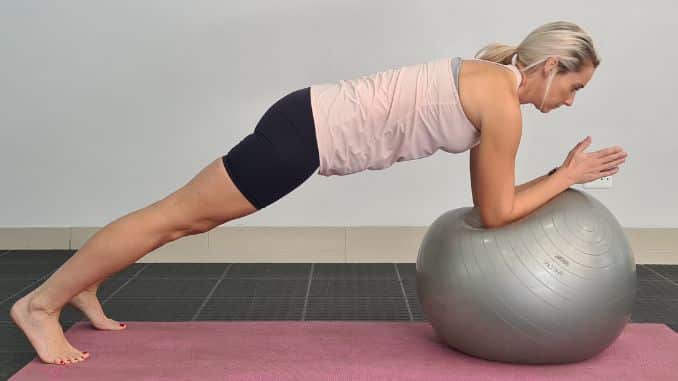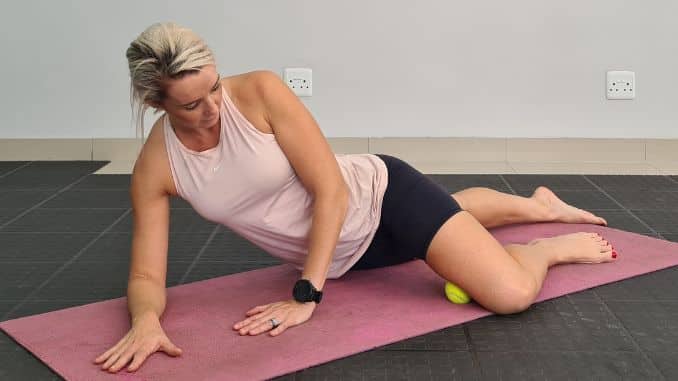
Stability balls are an incredibly versatile tool ideal for helping you build core strength and stability. Stability balls allow you to perform sit-to-stand exercises, side-lying activities, and other impossible dynamic movements with traditional equipment. These balls make working on your balance and posture much easier than using a standard barbell or dumbbell. Even better for workouts, the exercise ball offers many health benefits.
Benefits of Stability Ball Exercises
Exercise balls, also known as balance balls, Swiss balls, or yoga balls, have become increasingly popular as versatile tools for stability ball workouts in recent years. These large, inflatable balls come in various sizes and are used for various exercises that can help improve core strength, balance, flexibility, and overall fitness levels. We’ll explore some of the benefits of using exercise balls during exercise.
1. Improved Core Strength
One of the primary benefits of using Swiss balls is their ability to strengthen the core muscles. It promotes core exercise because as you roll forward, sit, or lie on the ball, your lower body part is forced to stabilize itself, engaging the deep abdominal and back muscles. This helps improve overall core strength, muscle endurance, and stability.
2. Better Balance
Using a stability ball can help improve balance, as it requires the engagement of multiple muscles in the body to maintain stability. When you sit on the ball with your legs extended straight, and arms extended overhead, your core muscles are engaged to keep your body balanced. It also helps improve coordination and stability. The unstable surface of the ball forces you to constantly adjust your body position, which can help improve your balance and reduce the risk of falls.
3. Increased Flexibility
Exercise balls can also be used for stretching exercises to improve flexibility. You can gently stretch your back, hips, and other muscles by lying on the ball and allowing your entire body to relax.
4. Reduced Back Pain
An exercise ball can help reduce back pain by improving posture and strengthening core muscles. Sitting on an exercise ball instead of a chair can help maintain balance, improve spinal alignment, and reduce pressure on the lower back.
5. More Efficient Workouts
A Swiss ball can add variety to your workout and help you target different muscle groups. Incorporating an exercise ball into your routine can challenge your body in new ways and make your workouts more efficient.
6. Cost-Effective
Exercise balls are relatively inexpensive compared to other types of fitness equipment, making them a cost-effective addition to your home gym.
Stability ball exercises are just plain fun! It’s a great way to mix up your workout routine and keep things interesting. Plus, you’ll never get bored because there are so many different exercises you can do with a stability ball. Here are a few of the best stability ball exercises you can try.
Large-Sized Stability Ball Exercises
Large-sized exercise stability balls are equipment designed to improve balance, stability, and core strength. They are typically made of durable, anti-burst materials such as PVC and are available in various sizes, the most common size being 65cm in diameter.
A. Ball Wall Squats
Begin upright with your feet shoulder-width apart with the stability ball positioned between your back and the wall. Move your legs out slightly and lean into the ball. Engage your core and bend your knees to move into a squat position, ideally bringing your knees to a 90-degree angle. Raise back up to an upright standing position, squeezing your glutes at the top position. Repeat the movement for 10 -15 repetitions.
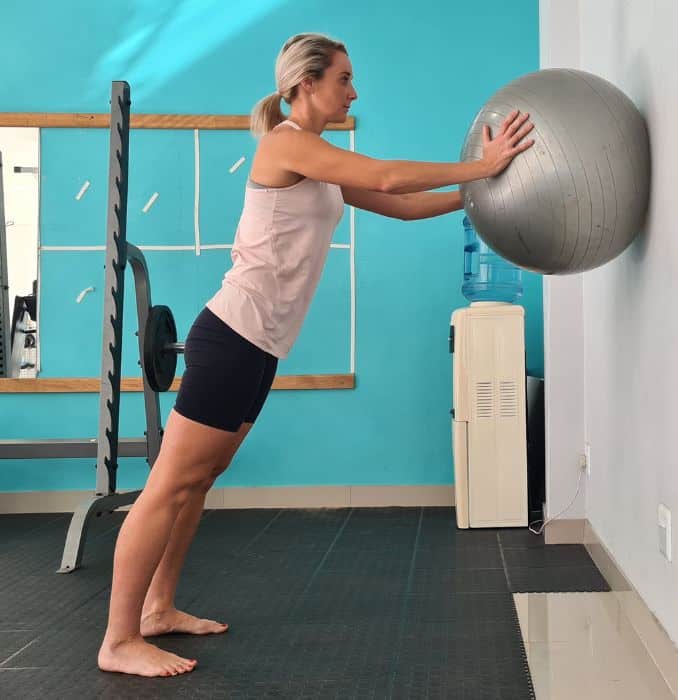 |
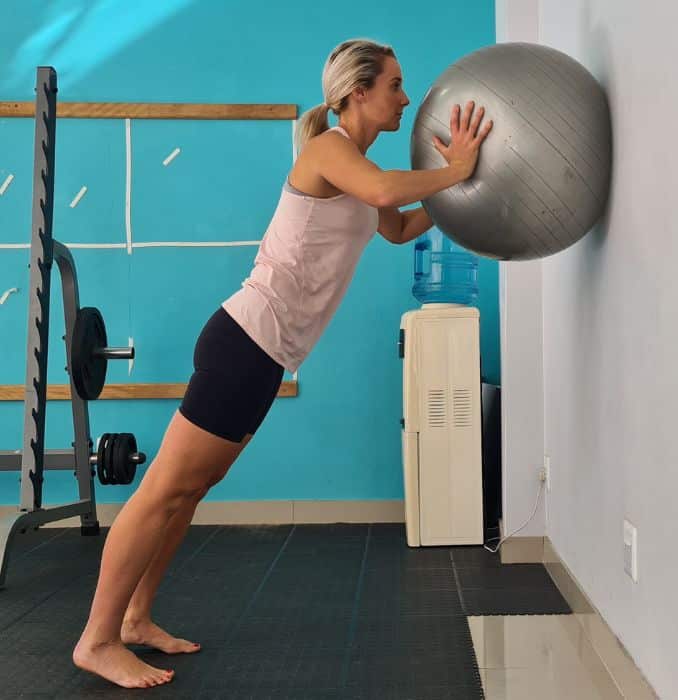 |
Ball Wall Squats
B. Stability Ball Crunch
Lie on your back on the stability ball with your knees bent and feet flat on the floor, maintaining good alignment with your head, shoulders, and hips. Cross your arms over your chest. With your core engaged, crunch your upper body forward with your gaze toward the sky. Hold the position for a couple of seconds. Return to the starting position. Repeat the movements for 10 repetitions.
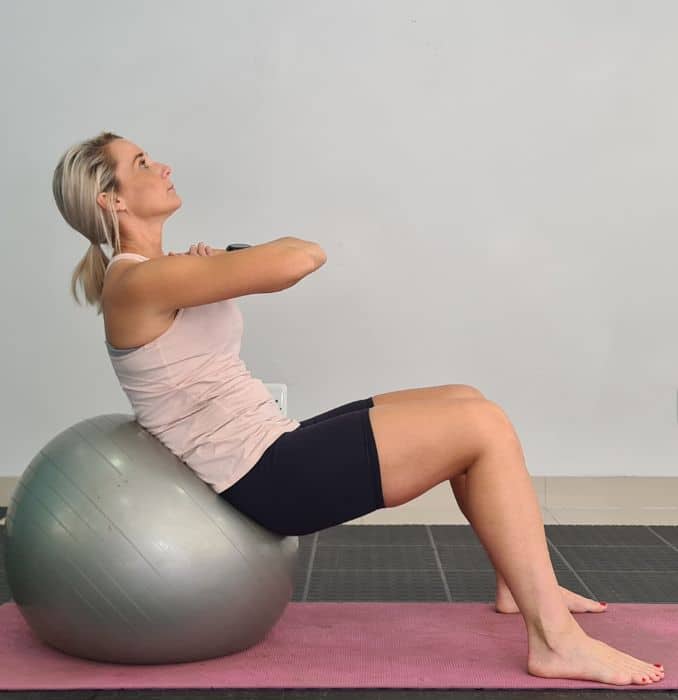 |
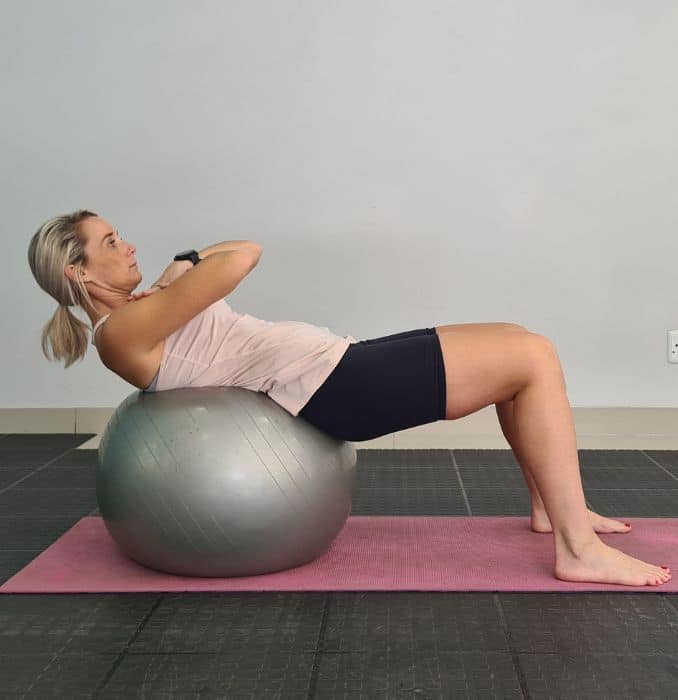 |
Sit-Ups or Crunches
Stability Ball Crunch is an advanced move that can take your core stability to the next level. This exercise targets the abs, obliques, and lower back muscles.
C. Push-ups
Begin in an upright kneeling position in front of the stability ball. Maintaining good alignment with your head, shoulders, and hips. Place your hands on the stability ball and move your knees back to increase the angle of your body. Engage your core and bend your elbows to lower your chest towards the stability ball. Return to the starting position and repeat the movement for 10 repetitions.
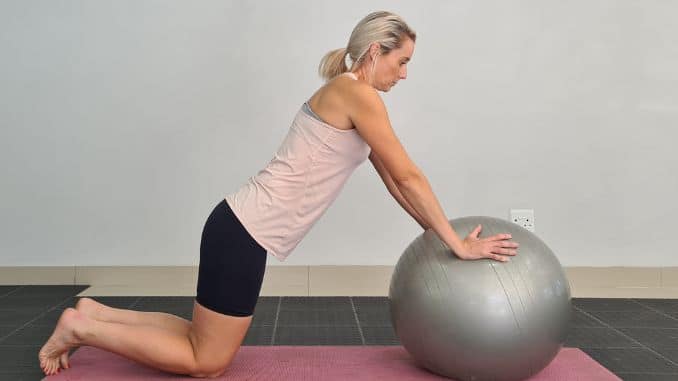 |
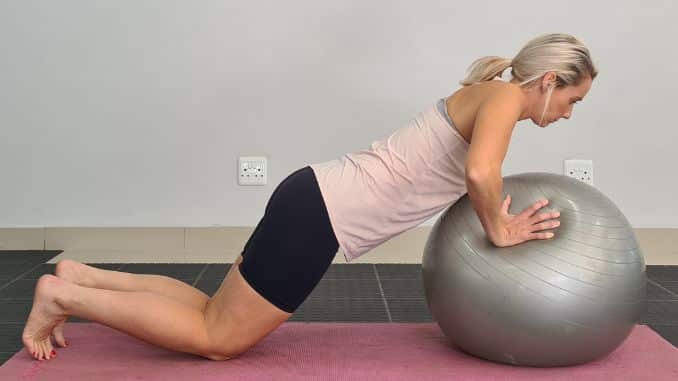 |
Push-Ups
D. Wall Push-Ups with Ball
Begin in an upright standing position in front of the wall with your feet hip-width apart, maintaining good alignment with your head, shoulders, hips, and legs. Position the stability ball on the wall at chest height and lean on the ball with your arms straight. Move your feet back to increase the angle of your body. Engage your core and slowly bend your elbows to lower your chest towards the ball. Return to the push-up position and repeat the movement for 10 repetitions.
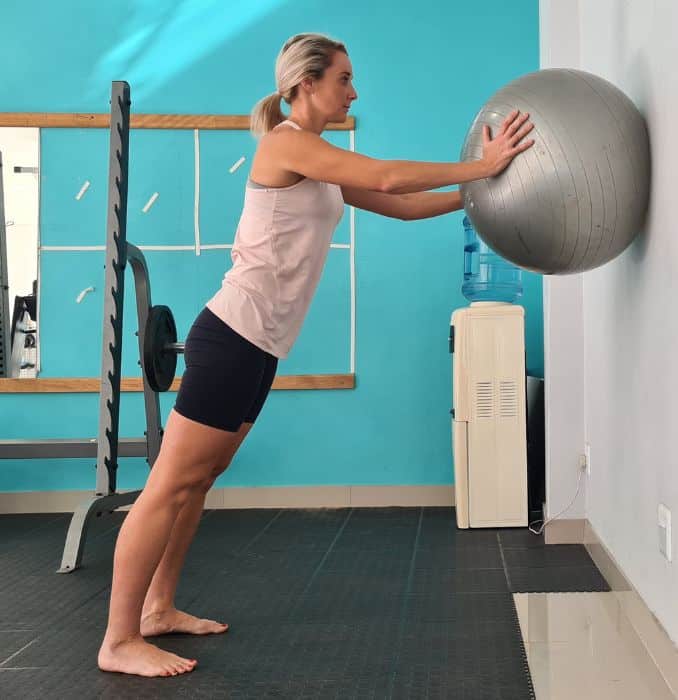 |
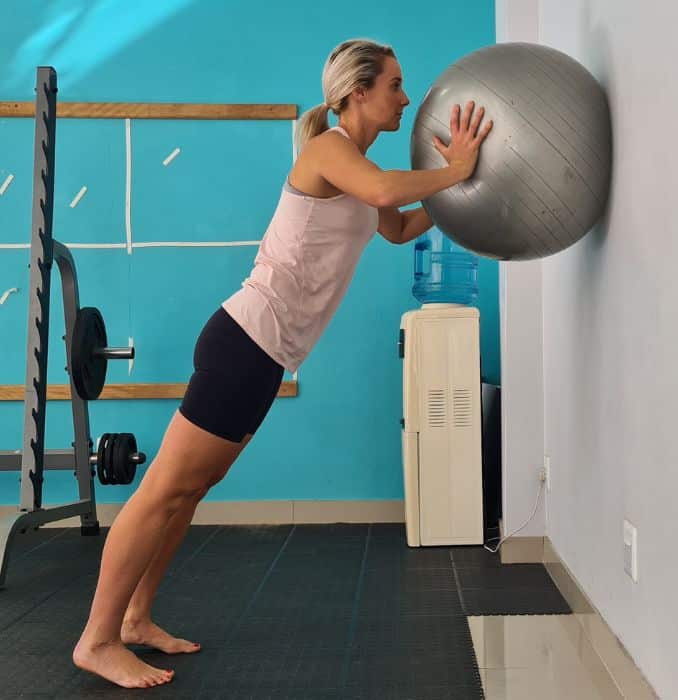 |
Wall Push-Ups with Ball
Push-ups are a great way to work your chest, triceps, and core muscles. This exercise is also great for improving your upper body strength and posture.
E. High Plank
Begin in an upright kneeling position in front of the stability ball. Move into a forearm plank position, resting your forearms on top of the stability ball and maintaining good alignment with your head, shoulders, hips, and toes. Hold the high plank position for several deep belly breaths, in through your nose and out through your mouth.
Plank
High plank position is one of the most popular stability ball exercises that involves keeping your body in a straight line while balancing on the stability ball. This exercise targets the entire core, shoulder blades, and upper back muscles.
Medium-Sized Stability Ball Exercises
A medium-sized stability ball is a type of exercise equipment slightly smaller than a large-sized stability ball and typically measures around 55cm in diameter.
A. Leg Squeeze with Squats
Begin in an upright standing position with your feet hip-width apart, maintaining good alignment with your head, shoulders, hips, and legs. Place a medium-sized stability ball between your knees. Engage your core and squeeze the ball with your legs. Hold this position for a couple of seconds, then bend your knees to move into a squat position. Relax and return to the starting position. Repeat the movement for 10 repetitions.
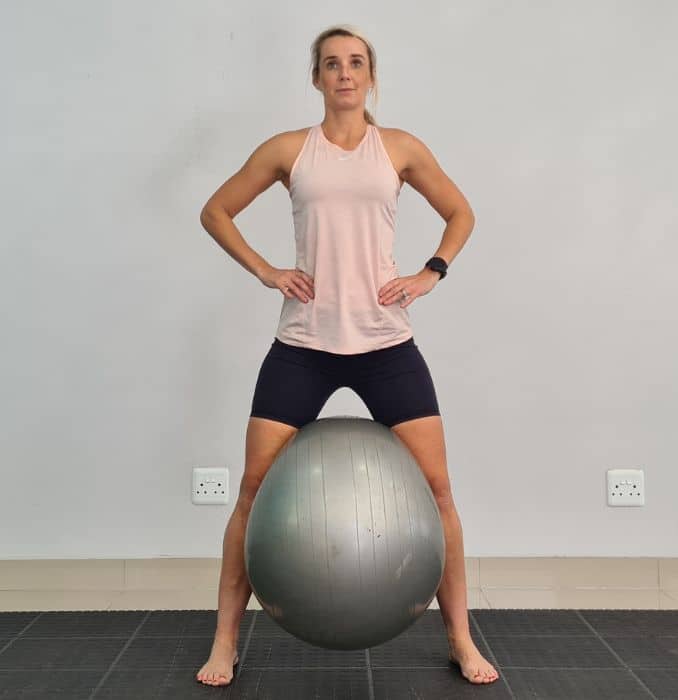 |
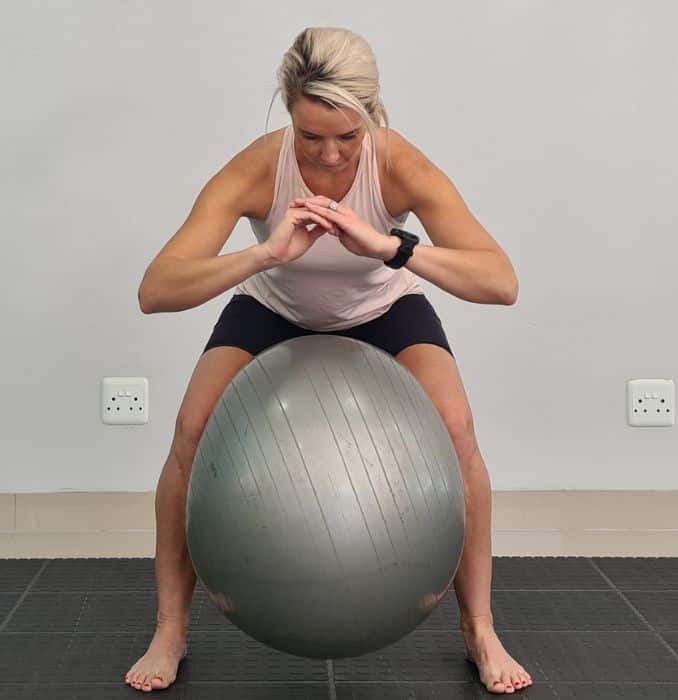 |
Leg Squeeze with Squats
B. Glute Bridge
Lie on your back on the floor with your knees bent and your feet flat, relaxing your upper body. Anchor your arms at your sides. Place a medium-sized stability ball between your knees. Contract your abdominal muscles, then push from your heels to lift your hips, squeezing your glutes at the top position. Hold this position for a couple of seconds. Relax and return to the starting position.
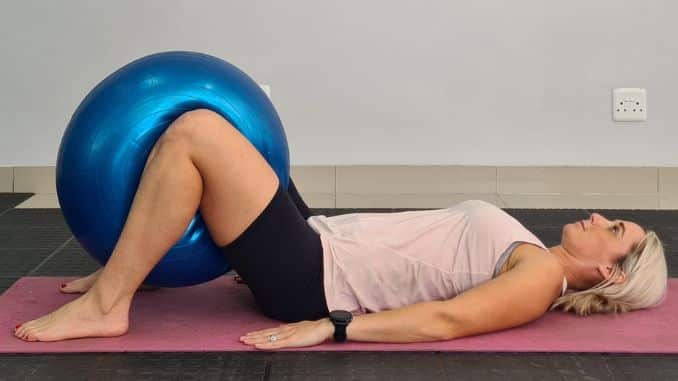 |
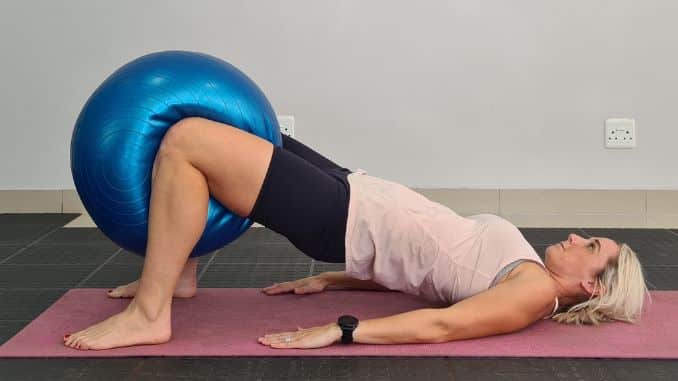 |
Glute Bridge
Small-Sized Stability Ball Exercises
A typical small-sized stability ball with a diameter of around 45cm.
A. Superman
Lie on your stomach with your legs straight. Bring your feet and legs close together, maintaining good alignment with your head, shoulders, hips, and legs. Extend your arms overhead, holding a small exercise ball. Engage your core and lift both legs and arms off the floor. Hold the position for a couple of seconds. Relax and repeat the movement.
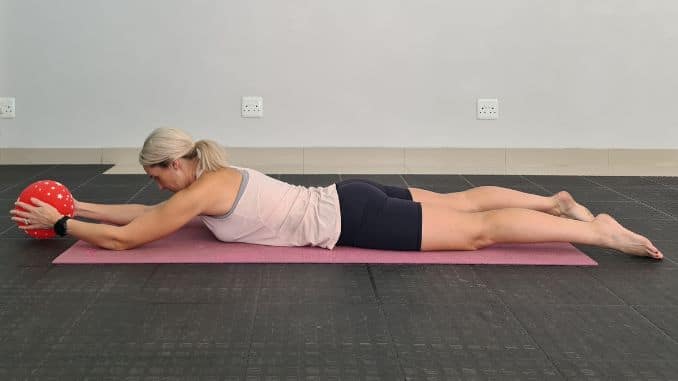 |
 |
Superman
Alternative Exercise:
Lie on your stomach on the floor with your feet shoulder-width apart, maintaining good alignment with your head, shoulders, hips, and legs. Position a small exercise ball between your ankles. Engage your core and gently lift both legs and arms, squeezing the stability ball tightly. Hold the position for a couple of seconds. Relax and repeat the movement.
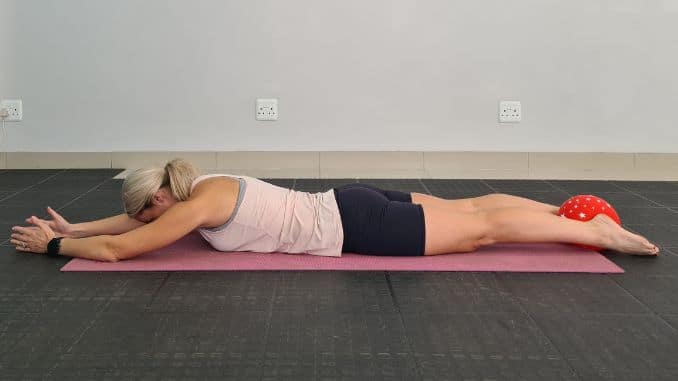 |
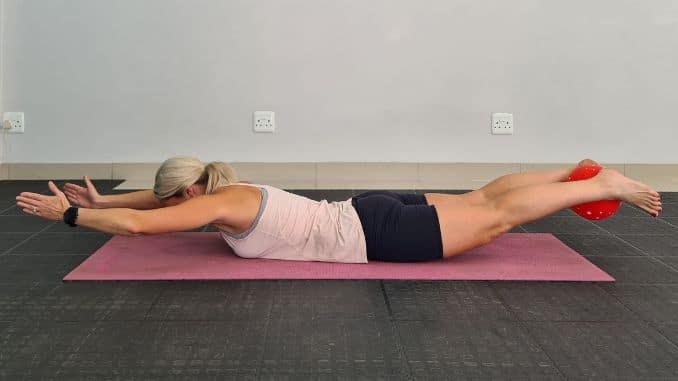 |
Alternative Exercise
B. V-Sits
Lie on your back on the floor, maintaining good alignment with your head, shoulders, hips, and legs. Extend your arms overhead and position a small stability ball between your ankles. Engage your core. Lift your legs toward the ceiling as you raise your upper body to grab the ball with both hands. Lower the ball towards the floor overhead as you lower your legs to return to a full-lying position. Repeat the sequence of movements for 5 repetitions.
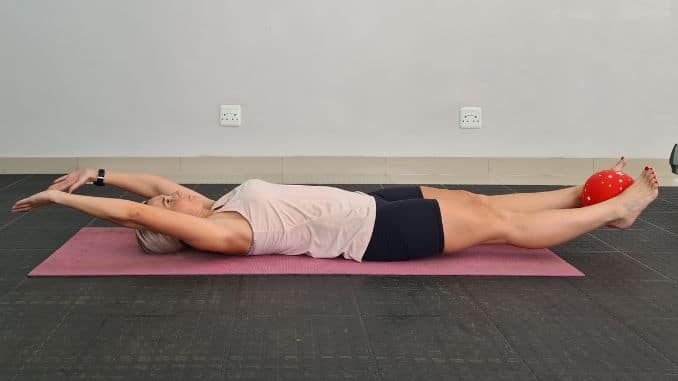 |
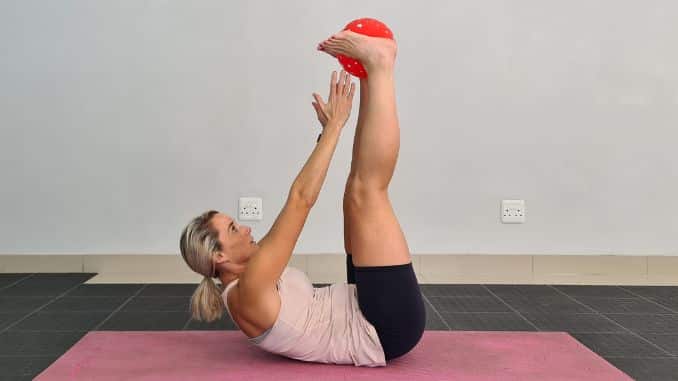 |
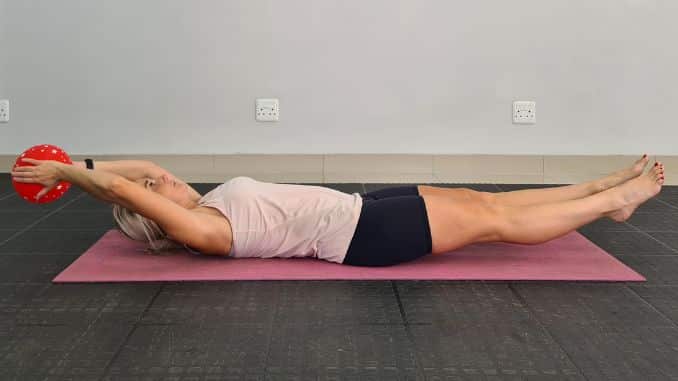 |
V-Sits
Variation 1
Lie on your back on the floor with your knees bent and feet flat. Place a stability ball between your knees. Engage your core and raise your upper body as you drive your knees toward your chest, squeezing the ball. Grab the ball with both hands, then lower the ball towards the floor overhead as you lower your legs until your feet are slightly hovering over the floor. Repeat the sequence of movements for 5 repetitions.
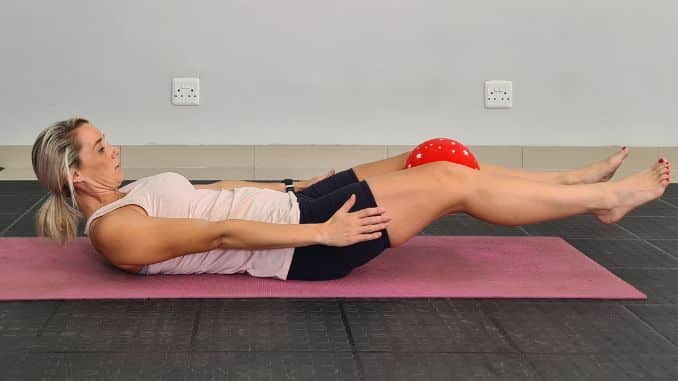 |
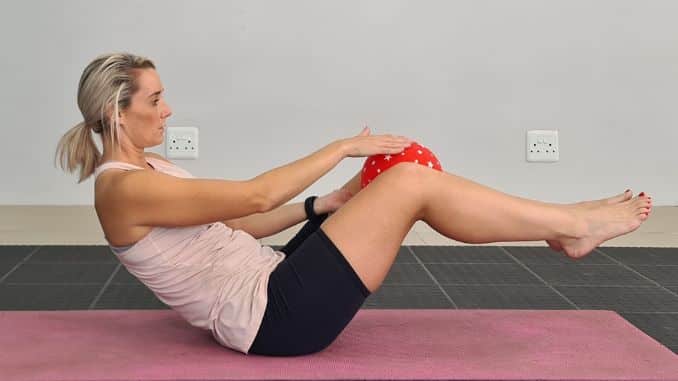 |
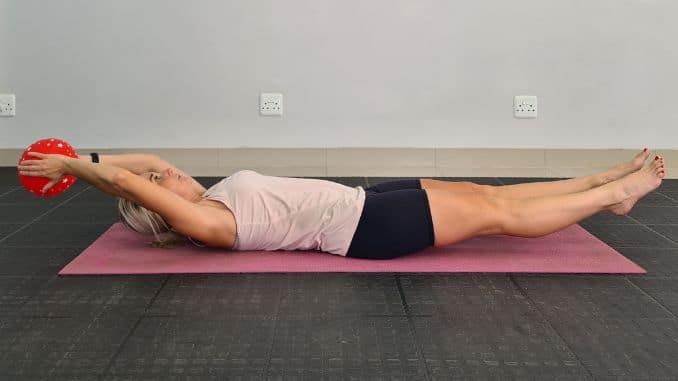 |
Variation 1
Variation 2
Sit upright on the floor with your knees bent and your feet flat. Place a small stability ball between your knees and lift your heels. Engage your core. Grab the ball with both hands and lean your upper body back, straightening your legs to be almost parallel to the floor while keeping your heels off the ground. Raise back up to return to the starting position, placing the ball again between your knees. Repeat the sequence of movements for 5 repetitions.
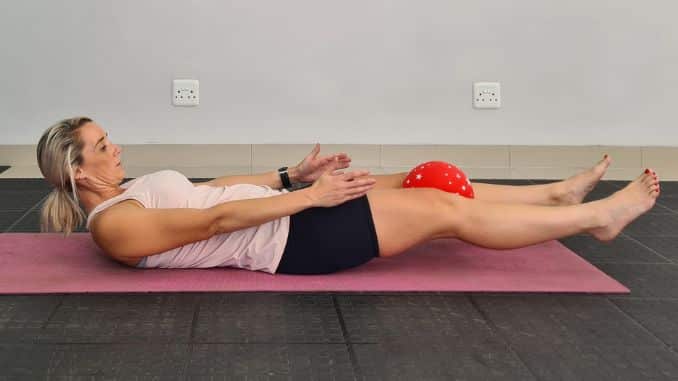 |
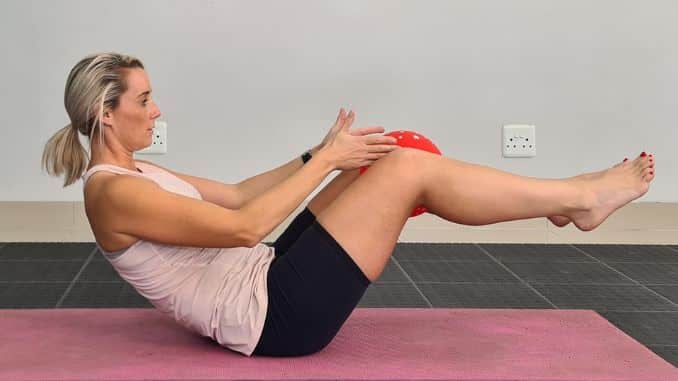 |
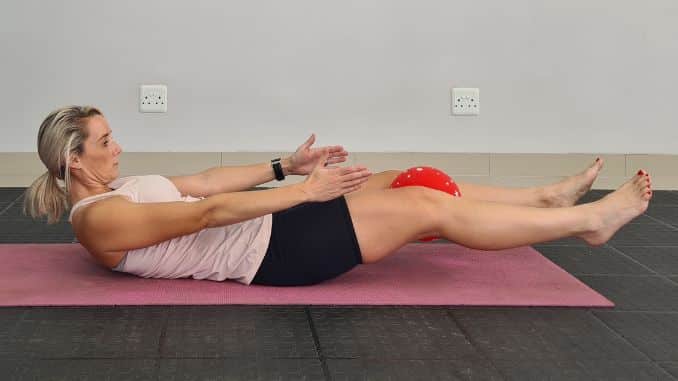 |
Variation 2
C. Hip Flexors Stretch
Move into a forearm plank position with the massage ball under your body, just above your hip area. Maintain good alignment with your head, shoulders, hips, and toes. Find any trigger points in your hip flexor area and roll the ball in small circular motions to relieve the sore spots. Increase or decrease the pressure as needed. Repeat the movement.
Hip Flexors Stretch
Variation 1
Sit upright on the floor with your knees bent and your feet flat. Place both hands at your sides for support. Cross your ankle over your opposite knee and place the massage ball under your glute area. Push your hands to lift your seat slightly from the ground, then run the ball from the bottom to the top and back. Repeat the movement.
Variation 2
Lie on your back on the floor with your knees bent and your heels on the floor. Place the massage ball under your upper back, lifting your upper body and maintaining good alignment with your head, shoulders, and hips. Find any trigger points and run the ball between your shoulders. Repeat the movement.
Fun Facts about Exercise Balls
- Exercise Balls, also known as exercise balls or Swiss balls, were first used in physical therapy in the 1960s.
- Exercise balls are more of soft elastic PVC, filled with air to create a firm yet bouncy surface.
- They were initially used in rehabilitation programs to help patients recover from injuries and surgeries.
- Swiss balls have become popular in fitness training and are now used in a wide range of exercises, including yoga, Pilates, and core strengthening workouts.
- Stability balls can be used as office chairs to improve posture and reduce the risk of back pain caused by prolonged sitting.
- They can be used as a tool for labor and delivery, as they can help women during the early stages of labor by providing support and encouraging movement.
Common Questions about Exercise Balls
1. Can you lift weights on an exercise ball?
Lifting weights while on an exercise ball is possible, but it requires proper technique and caution to ensure safety. If you’re considering using an exercise ball for weightlifting, kindly note the following:
-
Choose the right size ball:
The exercise ball should be the appropriate size for your height and weight. Using a too-small or too-big ball can be dangerous and cause instability.
-
Start with lighter weights:
If you’re new to weightlifting on an exercise ball, start with lighter weights and gradually increase the load as you become more comfortable and confident.
-
Engage your core:
Maintaining proper posture and engaging your core muscles is crucial for stability and balance. Keep your back straight and your core tight throughout the exercise.
2. How long should you exercise with the ball?
The time you should exercise using an exercise ball or stability ball depends on your fitness level and the type of workout you are doing. Generally, it’s recommended to start with 10-15 minutes of exercise and gradually increase the duration as your fitness level improves.
3. How long should you sit on an exercise ball at work?
If you’re using an exercise ball as an office chair, it’s recommended to start by sitting on it for a short period of time and gradually increasing the duration as your body adjusts. Begin with 20-30 minutes per day and gradually increase the duration over the course of several days or weeks. Alternating between sitting at the exercise ball and a traditional chair throughout the day is generally recommended. This can help with fatigue and discomfort from prolonged sitting in one position.
4. Does an exercise ball help you lose belly fat?
An exercise ball can help strengthen and tone the muscles in your core, but it alone may not lead to significant fat loss in the belly area. Losing belly fat requires a combination of regular exercise and a healthy diet. Using an exercise ball as an office chair can help you burn more calories throughout the day by engaging your core and increasing your overall activity level. To lose belly fat, it is important to combine regular exercise with a healthy diet high in protein, fiber, and healthy fats. This can help promote fat loss while preserving muscle mass and preventing muscle loss.
Conclusion:
Exercise balls are a favorite tool of many fitness professionals and personal trainers. It allows users of all fitness levels to strengthen their core and balance muscles throughout their whole body. Stability balls come in many forms and in different sizes, weights, and prices, but they all have a similar purpose — to help strengthen your core muscles and Lifting weights. Exercise balls have a few advantages over other types of exercise equipment. They are inexpensive, portable, and easy to use. Stability balls are perfect for home fitness enthusiasts and those with a limited budget.
When using a stability ball, it is important to select the right size for your body and ensure it is properly inflated. You should also use proper form and technique to avoid injury and maximize the benefits of the exercises.

